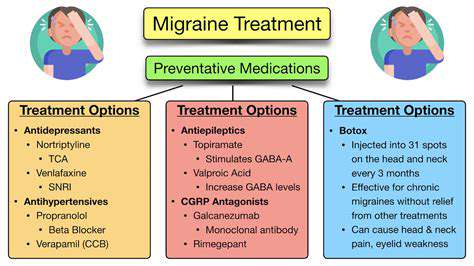The Link Between Migraines and Anxiety: Understanding the Connection
Understanding the Connection
Anxiety and migraines frequently intertwine in a self-perpetuating loop, though the exact mechanisms remain partially understood. Heightened anxiety appears to initiate physiological changes that affect cerebral blood flow and activate pain pathways, particularly involving the trigeminal nerve system. Recognizing this bidirectional relationship proves crucial for developing comprehensive treatment approaches.
The migraine-anxiety connection varies significantly between individuals. While anxiety clearly serves as a trigger for many, other factors like sleep disturbances, dietary changes, and environmental stressors also contribute. Personalized treatment requires careful identification of each person's unique trigger profile.
Anxiety's Impact on Migraine Symptoms
Anxiety doesn't merely precede migraines - it amplifies their severity. The stress response associated with anxiety intensifies pain perception, nausea, and sensory sensitivities, creating more debilitating episodes. This symptom exacerbation often leads to greater functional impairment and reduced quality of life.
The psychological dimension compounds the problem. Anticipatory anxiety about potential attacks creates a feedback loop that may increase attack frequency. Addressing this psychological component becomes as important as managing the physical symptoms.
Breaking the Cycle: Strategies for Relief
Effective management requires a multipronged approach addressing both conditions simultaneously. Mindfulness practices and relaxation techniques can modulate the stress response, potentially reducing attack frequency. Cognitive behavioral approaches help reframe catastrophic thinking patterns that exacerbate both anxiety and pain perception.
Lifestyle modifications form another critical component. Consistent sleep schedules, balanced nutrition, and regular physical activity help regulate the nervous system's stress response. Identifying and minimizing exposure to personal triggers provides additional protection against attacks.
Professional guidance remains essential for developing tailored treatment plans. Specialists can recommend appropriate medications, behavioral interventions, and support resources based on individual needs and symptom patterns.
Migraine Symptoms and Anxiety Symptoms: Overlapping Manifestations
Understanding Migraine Symptoms
Migraine attacks involve more than head pain - they represent complex neurological events. The characteristic throbbing often accompanies nausea, sensory hypersensitivities, and in some cases, temporary neurological disturbances called aura. This symptom variability makes accurate diagnosis challenging but essential for proper management.
The disabling nature of migraines extends beyond attack duration. Many sufferers experience migraine hangovers with residual fatigue and cognitive fog, while others live with anticipatory anxiety between attacks.
Anxiety Symptoms: A Closer Look
Anxiety disorders manifest through diverse physical and psychological symptoms. Beyond persistent worry, sufferers may experience palpitations, respiratory changes, and gastrointestinal disturbances. These physical manifestations often complicate diagnosis, as they mimic various medical conditions.
The cognitive burden proves equally significant. Constant vigilance and catastrophic thinking patterns drain mental energy, impair concentration, and reduce productivity. Recognizing these subtle but impactful symptoms facilitates earlier intervention.
Overlapping Symptoms: A Common Ground
Neurologically, migraine and anxiety share common pathways involving pain processing and emotional regulation centers. This neural overlap helps explain why each condition can exacerbate the other, creating complex clinical presentations that require integrated treatment approaches.
Potential Mechanisms: Exploring the Link
Shared neurochemical systems, particularly serotonin and norepinephrine pathways, likely contribute to symptom overlap. Dysregulation in these systems affects both pain perception and emotional processing. The hypothalamic-pituitary-adrenal axis, central to stress responses, also appears involved in both conditions.
Impact on Daily Life: The Ripple Effect
The combined burden of migraine and anxiety extends far beyond symptom experience. Work absenteeism, social withdrawal, and reduced life satisfaction commonly result. Effective management must address both the biological symptoms and their psychosocial consequences to truly improve quality of life.
Proper canine grooming begins with understanding coat characteristics. Dogs exhibit three primary coat types - short, medium, and long - each requiring specific care approaches to maintain skin and coat health.

Seeking Professional Help: The Importance of Diagnosis and Support

Seeking Professional Help for Mental Health
Recognizing the need for professional mental health support represents an important act of self-care. This decision reflects strength and commitment to personal wellbeing, providing access to specialized knowledge and evidence-based interventions. Mental health professionals create safe spaces for exploring challenges while developing effective coping strategies.
Therapists employ various approaches tailored to individual needs, addressing conditions ranging from mood disorders to trauma responses. This professional guidance helps restore balance and improve life satisfaction through structured, personalized interventions.
Understanding the Benefits of Therapy
Therapeutic work enhances emotional intelligence, interpersonal skills, and self-understanding. Effective therapy helps identify and modify unhelpful thought patterns, fostering healthier perspectives and behaviors. These changes often lead to improved relationships, increased resilience, and greater personal fulfillment.
The therapeutic journey facilitates profound personal growth. Through guided self-exploration, individuals develop tools for managing life's challenges while cultivating greater self-acceptance and purpose.
Recognizing When Professional Help is Needed
Persistent emotional distress, functional impairment, or worsening symptoms signal the need for professional evaluation. When self-management strategies prove insufficient or symptoms interfere significantly with daily life, seeking expert guidance becomes crucial. Early intervention often prevents symptom escalation and facilitates faster recovery.
Consulting trusted individuals can help assess whether professional support would be beneficial. Primary care providers often serve as helpful first contacts for mental health referrals.
Finding the Right Professional
Selecting an appropriate therapist involves considering specialization areas, therapeutic approaches, and personal comfort level. The therapeutic relationship's quality significantly influences outcomes, making personal connection an important factor in provider selection. Researching providers' backgrounds and consulting references can inform this important decision.
The search may require meeting several professionals before finding the right match, but this investment increases the likelihood of successful therapeutic outcomes. The ideal provider combines professional expertise with the ability to create a supportive, collaborative environment.